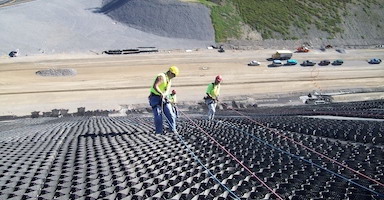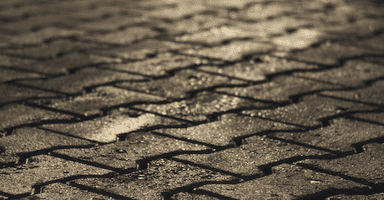28 OctGreen Parking Case Study

Before you can build a road or parking lot you have to start with a solid foundation. A stable foundation is especially important for green parking lots.
These environmentally friendly parking areas reduce stormwater runoff by incorporating porous products into the design. Green parking lots are not always green fields like this project, however, they all incorporate “green” into design.
Woven geotextile fabric, geogrid and cellular confinement systems are all geosynthetic solutions for parking lot base stabilization.
In this case study, we are going to explore a green parking project in West Point, Virginia that utilized a cellular confinement system to promote positive drainage and stabilize the site’s poor soil.
About the Project
The Pavilion at Riverwalk is a community area for the local farmer’s market and other recreational activities. The park features a large timber pavilion for events and an expansive green area. This green parking lot, an environmentally friendly alternative to traditional asphalt, serves as a parking lot for food trucks, farmers, artisans and community events.
It was critical to choose the right stabilizing solution for the parking area because the soil will be subject to significant load stress. Additionally, because the community envisions further development for the park, the product must lay the groundwork for a stable site.
Project Roadblocks
Poor Soil
Poor soil is a problem that plagues many job sites. If the soil is soft or weak, it won’t be able to withstand any vehicular load. Poor soil also causes hard surfaces to crack and pump.
Weak soils at green parking lot sites will result in volatile load support and poor vegetative establishment.
The native soils at this West Point project are weak for two reasons.
First, the Pavilion at Riverwalk site is located along the Mattaponi River. The soil near a river tends to be soft and silty. This means the soil has a low capacity for load support.
Second, this area was originally a dumping ground for a paper mill which means it is not a conducive environment for establishing vegetation.
Over Budget Bids
The original design and subsequent bids for the Pavilion at Riverwalk were over budget, a common problem for construction projects.
When project bids are over budget the owner has several options: cancel the project, request re-bids or work with potential partners on value engineering.
Value engineering is a review of the project design in order to improve the value of the project by reducing costs and/or increasing function.
The owner of the Pavilion at Riverwalk Project needed to reduce the cost of materials without compromising the long-term longevity of the green parking lot.
The civil contractor for the project approached Colonial Construction Materials for value engineering on the green parking lot. We worked with our manufacturing partner to supply a cellular confinement solution.
Site conditions, budgets, cell depths and infill types were all evaluated to determine the best product solution for the site. 4″ Geocell was chosen as the best product for the green parking lot.
Geocell: A Green Parking Solution
Geocell is a term for the honeycomb cellular confinement system that stabilizes soil. Geocell’s product design and material varies by manufacturer. We currently supply Presto Geosystem’s GEOWEB Geocell. An alternative geocell product was installed for the Pavilion at Riverwalk project and thus all of the following information reflects the details about that specific geocell product. Although we have since changed manufacturers, we stand by the performance of the geocell installed for this green parking lot.

Geocell’s have a honeycomb structure of perforated cells. The cellular panels are manufactured from 100% virgin HDPE which is a cost-effective yet functional material. Virgin HDPE is strong, lightweight, flexible and has excellent corrosion resistance.
This type of cellular confinement system has 58 strips of cells that ship as collapsed panels.

The panel’s cells vary in depth which can be 3”, 4”, 6” or 8”.
Each geocell panel is 8.4’ in expanded width.
Fill cells with topsoil, stone or concrete. In many cases, you can utilize on-site material which is a cost-saving opportunity for the contractor.
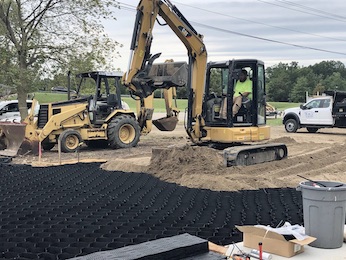
Applications for geocell vary from soil stabilization, like the Pavilion at Riverwalk, to erosion control, retaining walls and channel protection.
After site-work and grading, 6 inches of #57 stone was compacted to create a base.
Next, a layer of nonwoven geotextile fabric was installed. The drainage fabric separates the stone base from the geocells and improves the site’s drainage.
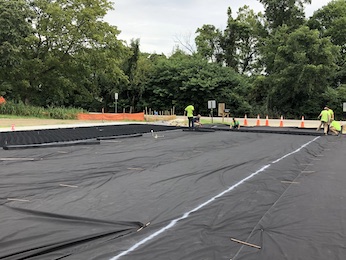
10,000 square feet of 4″ geocell was then installed over the geotextile fabric. The panels were connected with heavy duty zip ties.
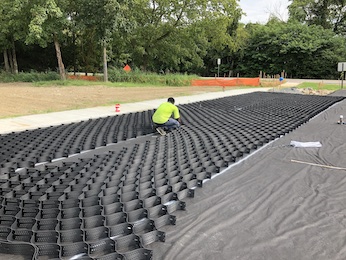
The cellular confinement system was then filled with 6 inches of topsoil.
The final step was hydroseeding to establish vegetation. The hydroseeding slurry contained 100% Cellulose Hydromulch, Annual Rye, K-31 Fescue and 15-30-15 Fertilizer.
The Pavilion at Riverwalk is now stable, vegetated and ready to support the park’s future events.
Designing with Geocell
This green parking lot is just one example of how to value engineer geocells into site design.
If you have a project that would benefit from this cellular confinement product, contact our sales team so we can help.
Read More About Geocell
Presto Geosystems Now Available at Colonial Construction Materials
New Manufacture Announcement: Now Supplying Presto Geosystems Our entire team at Colonial Construction Materials is…
Permeable Paving Solutions
Managing stormwater is a critical concern for municipalities, engineers and developers. As our communities grow…


